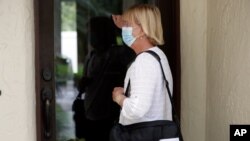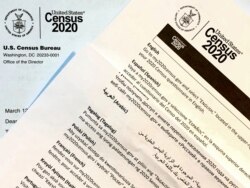Out on her first day of knocking on doors in the Bay Area, the census taker had limited success getting people to answer the questions on the 2020 census.
Residents at only two homes answered all the questions about how many people lived there, what their relationships were and their sex, age, race and whether they're Hispanic. No one was home at three households, residents at two homes wouldn't give her the time of day, and the rest only answered some questions.
Workers on the front-lines of the massive effort trying to count everyone in the U.S. have faced unprecedented obstacles in the last phase of the 2020 census: people wary of talking to strangers in a pandemic and distrustful of government; a shortened schedule; administrative snafus, and nagging concerns about the quality of the protective equipment they've received.
The California census taker and others interviewed by The Associated Press asked not to be identified for fear of losing their jobs — they are prohibited by the bureau from talking to reporters. Up to a half million census takers started hitting the streets last week to knock on the doors of around 56 million homes that haven't yet responded to the 2020 census. The AP talked to two census takers in California, two in Alaska and one each in Florida and Massachusetts, and the concerns they raised were similar.
Following her training, the California census taker tried to establish a rapport by smiling frequently, but that chemistry was hampered by her mask. She also told them she was just trying to do her job in an effort to win them over. She was taken aback by how reluctant people were last Tuesday, either for privacy reasons or distrust of the government.
At a couple of houses, she knew the family, but even then they didn't want to be interviewed by her, though they were happy to share neighborhood gossip.
Several census workers said they wished the personal protective equipment the Census Bureau gave them was of higher quality. The census takers, also called enumerators, were given white cloth masks, some made by underwear manufacturer HanesBrands, and a small bottle of bourbon-scented hand sanitizer made by a distillery in Oklahoma. Census takers also were told to conduct interviews outside as much as possible and maintain 6 feet (2 meters) of distance from people they interview.
The Florida enumerator said her mask was flimsy and too big for her face. One of the California census takers described the masks as "stretchy" and lacking a filter. A spokeswoman for the Census Bureau said the masks conformed to CDC guidelines, were washable and could be reused up to 10 times.
Johnny Zuagar, who is president of a union that represents permanent census workers but not the temporary census takers, said he thought the Census Bureau did the best it could on masks, given the competition from other companies in ordering 2.4 million masks.
"They are trying to do something unprecedented," said Zuagar, president of Census Council 241.
The census helps determine how $1.5 trillion in federal spending is distributed and how many congressional seats and Electoral College votes each state gets.
Some of the census takers said the training they received was fraught with administrative confusion. The Florida census taker received a phone call two weeks ago, asking her to show up for an in-person training session across town 10 minutes before it was supposed to start. A week later, after she met her supervisor, she still had not been able to start her online training sessions because she was switched into another group of enumerators and her new supervisor had not yet contacted her.
One of the California census-takers said he was sent an email notice about a virtual training session hours after it was supposed to have taken place. No one told the Massachusetts census taker he needed to bring his Social Security card or passport for in-person training.
The Massachusetts census taker said he had been disappointed in the way his supervisor was communicating with him.
The 2020 census has been whip-lashed by a constantly changing schedule. The door-knocking phase was supposed to start in May and wrap up at the end of July, but the pandemic pushed the start for most census takers back to August with a deadline for wrapping up the head count at the end of October.
But the Census Bureau recently announced it would end the count a month early, at the end of September, after requests for deadline extensions stalled in Congress. The inaction in the Republican-controlled Senate coincides with a memorandum President Donald Trump issued last month to try to exclude people living in the U.S. illegally from being part of the process for redrawing congressional districts.
Census takers this year have to reach 8 million more homes than they did in 2010, and they have only six weeks instead of the 10 weeks they did a decade ago, according to an analysis by the Center for Urban Research at CUNY. Forty-eight senators, including Alaska's two Republican senators, last week sent a letter to Senate and House leaders urging them to extend the deadlines.
The Alaska census taker worried that lopping off a month from the schedule would sabotage the count.
In Idaho, Wendy Jaquet, who is co-chairing that state's census efforts, says she's already seeing the impact of the door-knockers as the state's response rate has edged up this week.
"That has made me more encouraged," Jaquet said.
Census advocates and some U.S. Census Bureau officials have said the extensions were needed, not only to get the work done, but also to avoid confusing people about when the census was ending.
"We are fearful that a lot of undercounted communities will not complete it because they think it ends Oct. 31," said Sabeen Perwaiz, who is leading an alliance of nonprofits in effort to increase census participation in Florida. "We absolutely think there will be some confusion in communities.






